Aboriginal Teenage Pregnancy: Social Complexities and Health Factors
VerifiedAdded on 2023/01/06
|12
|3022
|2
Essay
AI Summary
This essay delves into the issue of Aboriginal teenage pregnancy in Australia, exploring its complexities and the factors contributing to it. It begins by outlining the prevalence of teenage pregnancy within the Aboriginal and Torres Strait Islander communities, highlighting the higher rates compared to the non-indigenous population and the associated consequences such as dropping out of school, increased health risks, and risky behaviors. The essay then examines the social determinants of health (SDOH) that influence teenage pregnancy, including education, risky behaviors, location, employment, and cultural practices. It further discusses intervention programs implemented to address the issue, such as sex education in schools using infant simulators, and provides a critique of these programs, addressing their limitations and potential unintended consequences. The essay concludes by summarizing the key findings and emphasizing the need for comprehensive strategies to tackle this significant public health challenge.
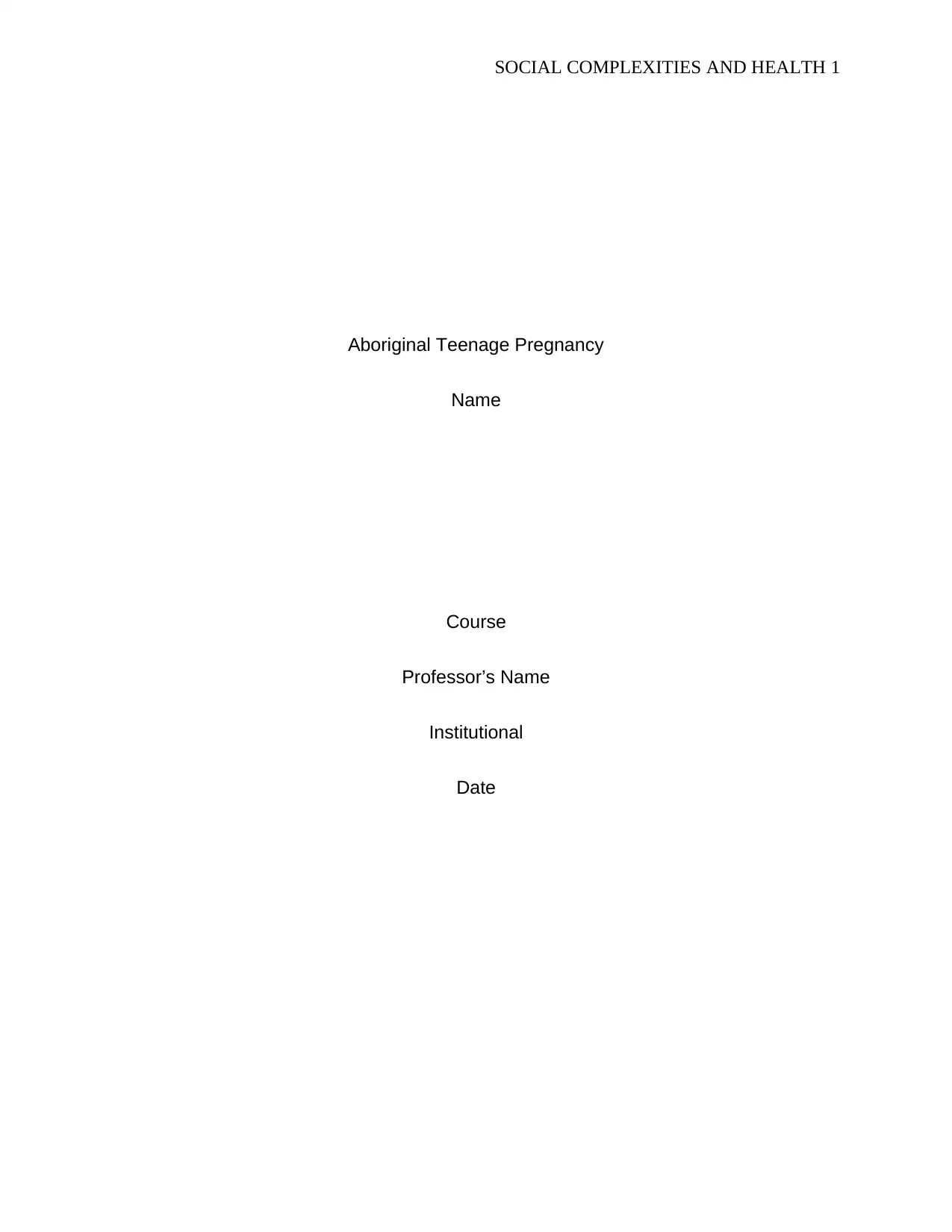
SOCIAL COMPLEXITIES AND HEALTH 1
Aboriginal Teenage Pregnancy
Name
Course
Professor’s Name
Institutional
Date
Aboriginal Teenage Pregnancy
Name
Course
Professor’s Name
Institutional
Date
Paraphrase This Document
Need a fresh take? Get an instant paraphrase of this document with our AI Paraphraser
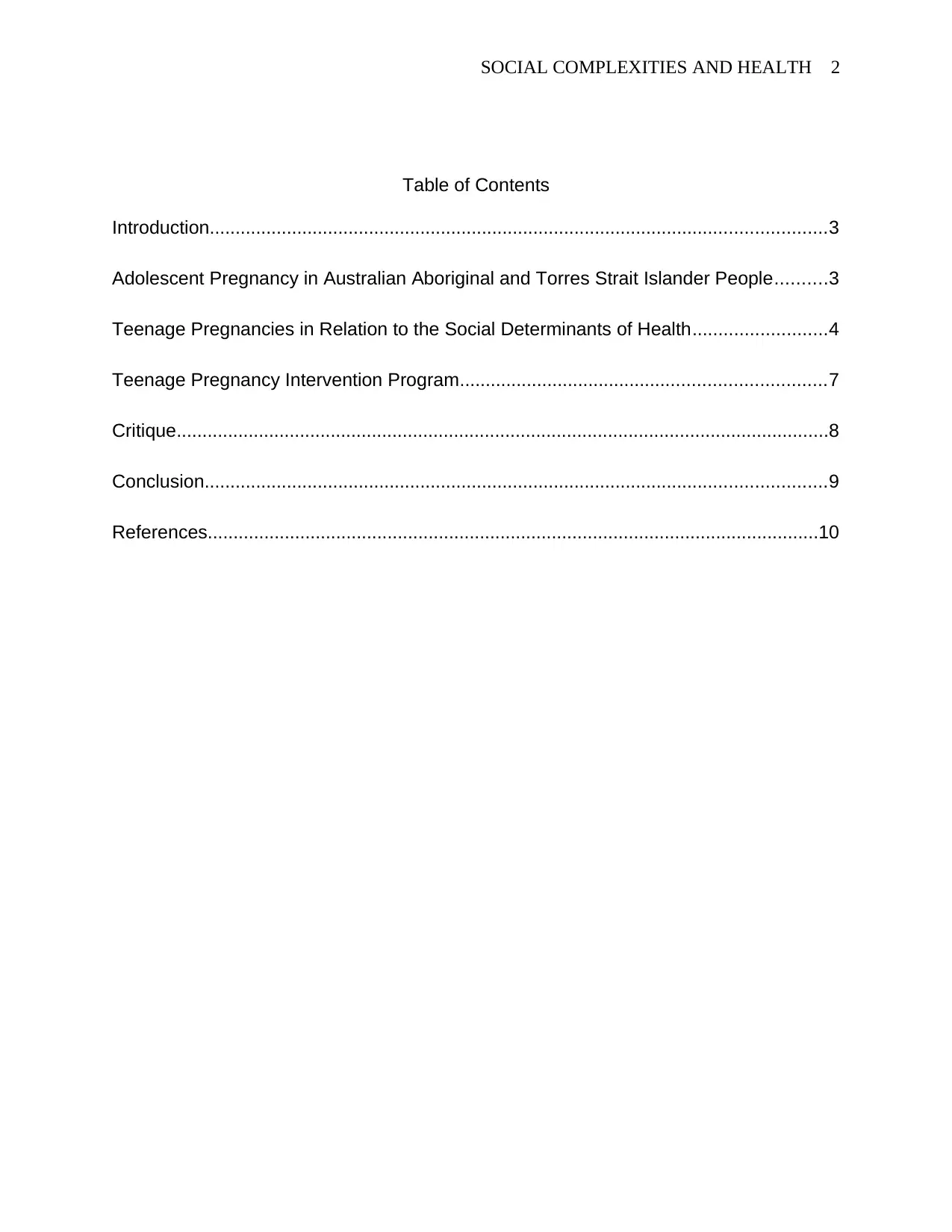
SOCIAL COMPLEXITIES AND HEALTH 2
Table of Contents
Introduction........................................................................................................................3
Adolescent Pregnancy in Australian Aboriginal and Torres Strait Islander People..........3
Teenage Pregnancies in Relation to the Social Determinants of Health..........................4
Teenage Pregnancy Intervention Program.......................................................................7
Critique...............................................................................................................................8
Conclusion.........................................................................................................................9
References.......................................................................................................................10
Table of Contents
Introduction........................................................................................................................3
Adolescent Pregnancy in Australian Aboriginal and Torres Strait Islander People..........3
Teenage Pregnancies in Relation to the Social Determinants of Health..........................4
Teenage Pregnancy Intervention Program.......................................................................7
Critique...............................................................................................................................8
Conclusion.........................................................................................................................9
References.......................................................................................................................10
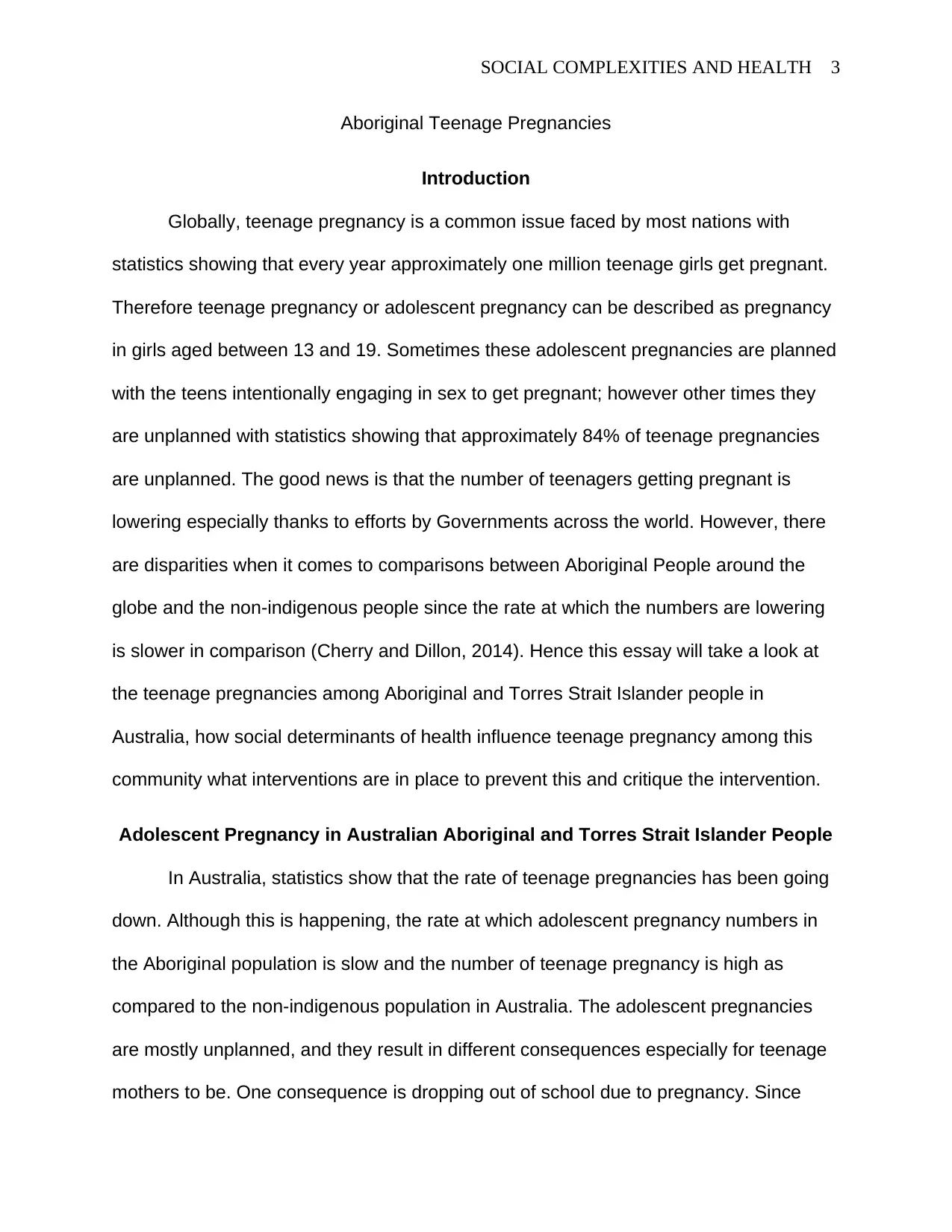
SOCIAL COMPLEXITIES AND HEALTH 3
Aboriginal Teenage Pregnancies
Introduction
Globally, teenage pregnancy is a common issue faced by most nations with
statistics showing that every year approximately one million teenage girls get pregnant.
Therefore teenage pregnancy or adolescent pregnancy can be described as pregnancy
in girls aged between 13 and 19. Sometimes these adolescent pregnancies are planned
with the teens intentionally engaging in sex to get pregnant; however other times they
are unplanned with statistics showing that approximately 84% of teenage pregnancies
are unplanned. The good news is that the number of teenagers getting pregnant is
lowering especially thanks to efforts by Governments across the world. However, there
are disparities when it comes to comparisons between Aboriginal People around the
globe and the non-indigenous people since the rate at which the numbers are lowering
is slower in comparison (Cherry and Dillon, 2014). Hence this essay will take a look at
the teenage pregnancies among Aboriginal and Torres Strait Islander people in
Australia, how social determinants of health influence teenage pregnancy among this
community what interventions are in place to prevent this and critique the intervention.
Adolescent Pregnancy in Australian Aboriginal and Torres Strait Islander People
In Australia, statistics show that the rate of teenage pregnancies has been going
down. Although this is happening, the rate at which adolescent pregnancy numbers in
the Aboriginal population is slow and the number of teenage pregnancy is high as
compared to the non-indigenous population in Australia. The adolescent pregnancies
are mostly unplanned, and they result in different consequences especially for teenage
mothers to be. One consequence is dropping out of school due to pregnancy. Since
Aboriginal Teenage Pregnancies
Introduction
Globally, teenage pregnancy is a common issue faced by most nations with
statistics showing that every year approximately one million teenage girls get pregnant.
Therefore teenage pregnancy or adolescent pregnancy can be described as pregnancy
in girls aged between 13 and 19. Sometimes these adolescent pregnancies are planned
with the teens intentionally engaging in sex to get pregnant; however other times they
are unplanned with statistics showing that approximately 84% of teenage pregnancies
are unplanned. The good news is that the number of teenagers getting pregnant is
lowering especially thanks to efforts by Governments across the world. However, there
are disparities when it comes to comparisons between Aboriginal People around the
globe and the non-indigenous people since the rate at which the numbers are lowering
is slower in comparison (Cherry and Dillon, 2014). Hence this essay will take a look at
the teenage pregnancies among Aboriginal and Torres Strait Islander people in
Australia, how social determinants of health influence teenage pregnancy among this
community what interventions are in place to prevent this and critique the intervention.
Adolescent Pregnancy in Australian Aboriginal and Torres Strait Islander People
In Australia, statistics show that the rate of teenage pregnancies has been going
down. Although this is happening, the rate at which adolescent pregnancy numbers in
the Aboriginal population is slow and the number of teenage pregnancy is high as
compared to the non-indigenous population in Australia. The adolescent pregnancies
are mostly unplanned, and they result in different consequences especially for teenage
mothers to be. One consequence is dropping out of school due to pregnancy. Since
⊘ This is a preview!⊘
Do you want full access?
Subscribe today to unlock all pages.

Trusted by 1+ million students worldwide
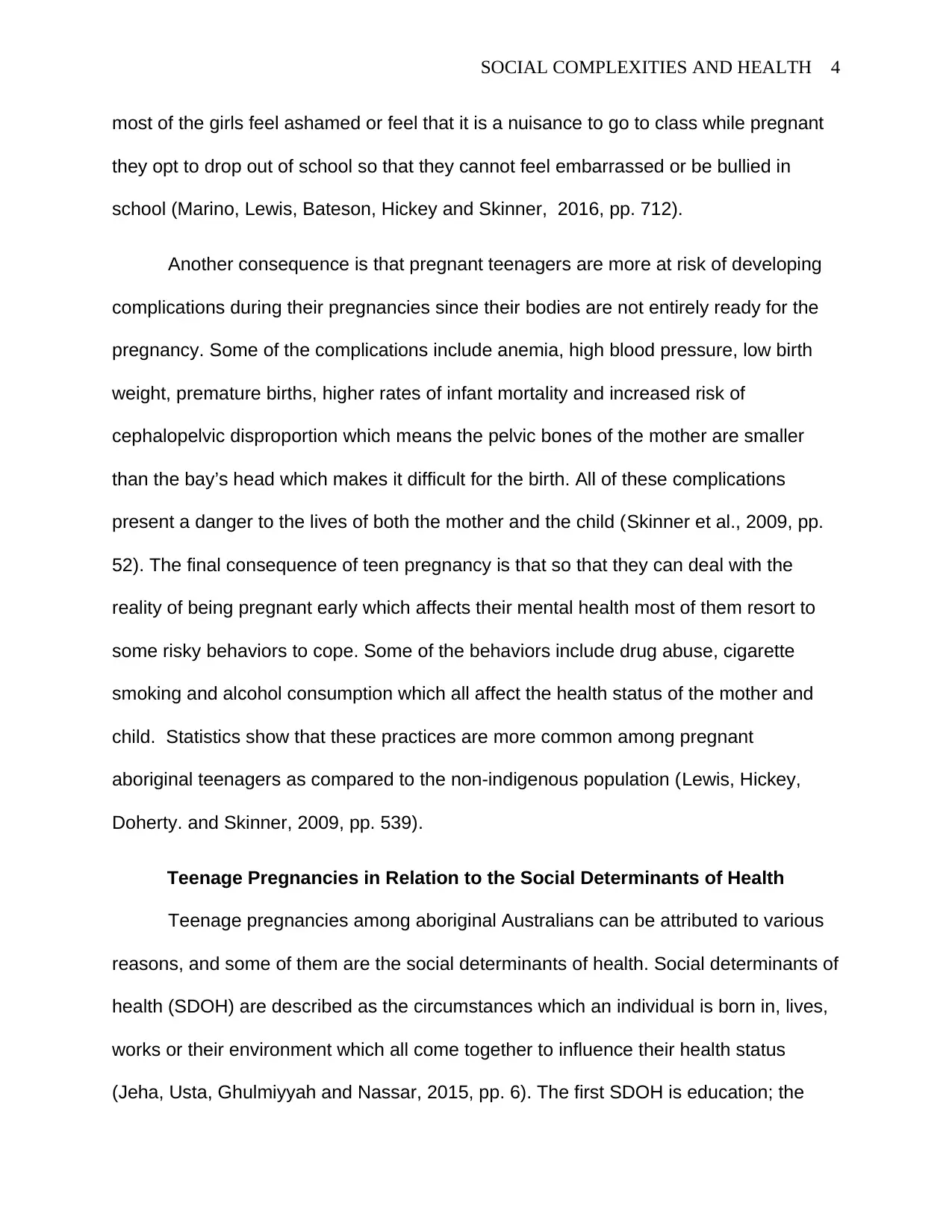
SOCIAL COMPLEXITIES AND HEALTH 4
most of the girls feel ashamed or feel that it is a nuisance to go to class while pregnant
they opt to drop out of school so that they cannot feel embarrassed or be bullied in
school (Marino, Lewis, Bateson, Hickey and Skinner, 2016, pp. 712).
Another consequence is that pregnant teenagers are more at risk of developing
complications during their pregnancies since their bodies are not entirely ready for the
pregnancy. Some of the complications include anemia, high blood pressure, low birth
weight, premature births, higher rates of infant mortality and increased risk of
cephalopelvic disproportion which means the pelvic bones of the mother are smaller
than the bay’s head which makes it difficult for the birth. All of these complications
present a danger to the lives of both the mother and the child (Skinner et al., 2009, pp.
52). The final consequence of teen pregnancy is that so that they can deal with the
reality of being pregnant early which affects their mental health most of them resort to
some risky behaviors to cope. Some of the behaviors include drug abuse, cigarette
smoking and alcohol consumption which all affect the health status of the mother and
child. Statistics show that these practices are more common among pregnant
aboriginal teenagers as compared to the non-indigenous population (Lewis, Hickey,
Doherty. and Skinner, 2009, pp. 539).
Teenage Pregnancies in Relation to the Social Determinants of Health
Teenage pregnancies among aboriginal Australians can be attributed to various
reasons, and some of them are the social determinants of health. Social determinants of
health (SDOH) are described as the circumstances which an individual is born in, lives,
works or their environment which all come together to influence their health status
(Jeha, Usta, Ghulmiyyah and Nassar, 2015, pp. 6). The first SDOH is education; the
most of the girls feel ashamed or feel that it is a nuisance to go to class while pregnant
they opt to drop out of school so that they cannot feel embarrassed or be bullied in
school (Marino, Lewis, Bateson, Hickey and Skinner, 2016, pp. 712).
Another consequence is that pregnant teenagers are more at risk of developing
complications during their pregnancies since their bodies are not entirely ready for the
pregnancy. Some of the complications include anemia, high blood pressure, low birth
weight, premature births, higher rates of infant mortality and increased risk of
cephalopelvic disproportion which means the pelvic bones of the mother are smaller
than the bay’s head which makes it difficult for the birth. All of these complications
present a danger to the lives of both the mother and the child (Skinner et al., 2009, pp.
52). The final consequence of teen pregnancy is that so that they can deal with the
reality of being pregnant early which affects their mental health most of them resort to
some risky behaviors to cope. Some of the behaviors include drug abuse, cigarette
smoking and alcohol consumption which all affect the health status of the mother and
child. Statistics show that these practices are more common among pregnant
aboriginal teenagers as compared to the non-indigenous population (Lewis, Hickey,
Doherty. and Skinner, 2009, pp. 539).
Teenage Pregnancies in Relation to the Social Determinants of Health
Teenage pregnancies among aboriginal Australians can be attributed to various
reasons, and some of them are the social determinants of health. Social determinants of
health (SDOH) are described as the circumstances which an individual is born in, lives,
works or their environment which all come together to influence their health status
(Jeha, Usta, Ghulmiyyah and Nassar, 2015, pp. 6). The first SDOH is education; the
Paraphrase This Document
Need a fresh take? Get an instant paraphrase of this document with our AI Paraphraser
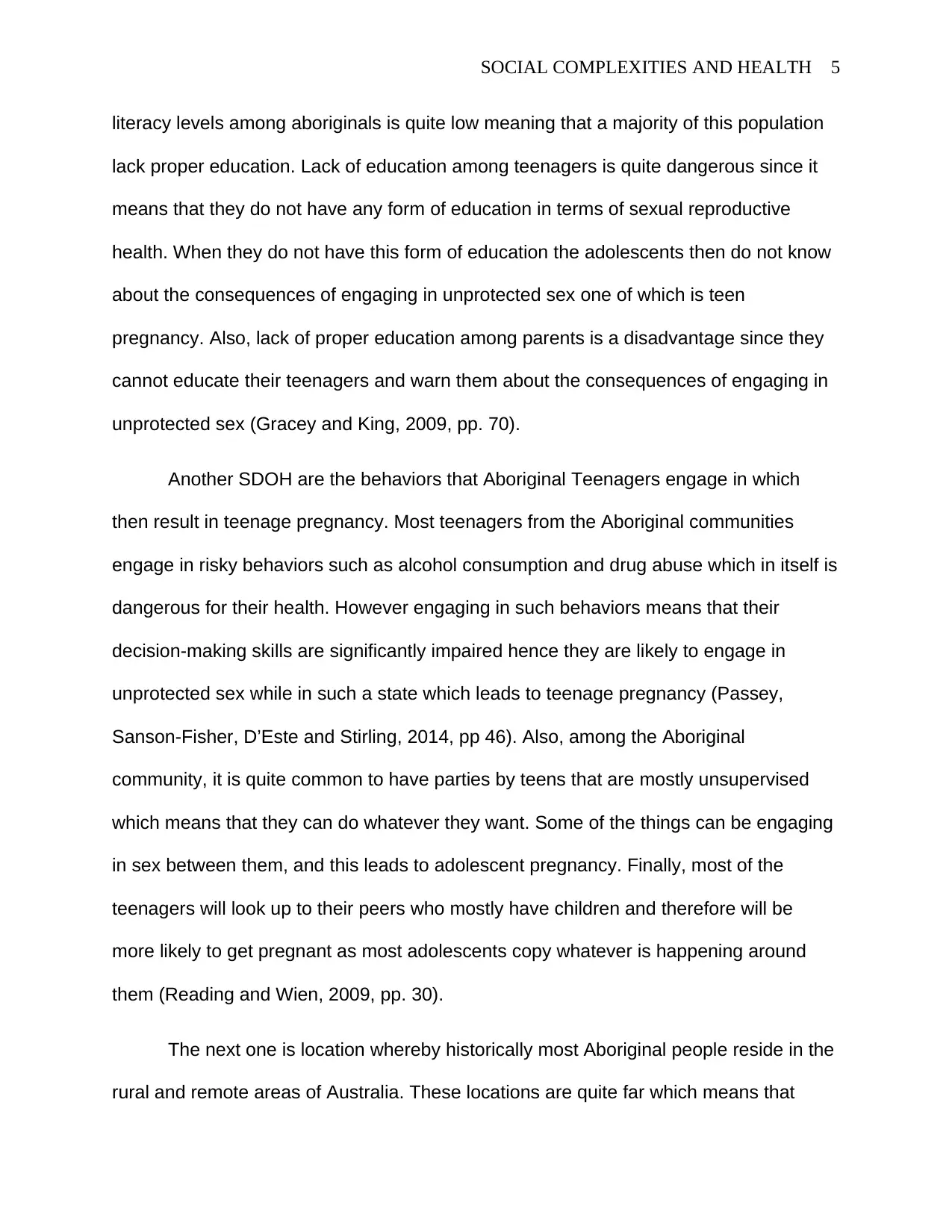
SOCIAL COMPLEXITIES AND HEALTH 5
literacy levels among aboriginals is quite low meaning that a majority of this population
lack proper education. Lack of education among teenagers is quite dangerous since it
means that they do not have any form of education in terms of sexual reproductive
health. When they do not have this form of education the adolescents then do not know
about the consequences of engaging in unprotected sex one of which is teen
pregnancy. Also, lack of proper education among parents is a disadvantage since they
cannot educate their teenagers and warn them about the consequences of engaging in
unprotected sex (Gracey and King, 2009, pp. 70).
Another SDOH are the behaviors that Aboriginal Teenagers engage in which
then result in teenage pregnancy. Most teenagers from the Aboriginal communities
engage in risky behaviors such as alcohol consumption and drug abuse which in itself is
dangerous for their health. However engaging in such behaviors means that their
decision-making skills are significantly impaired hence they are likely to engage in
unprotected sex while in such a state which leads to teenage pregnancy (Passey,
Sanson-Fisher, D’Este and Stirling, 2014, pp 46). Also, among the Aboriginal
community, it is quite common to have parties by teens that are mostly unsupervised
which means that they can do whatever they want. Some of the things can be engaging
in sex between them, and this leads to adolescent pregnancy. Finally, most of the
teenagers will look up to their peers who mostly have children and therefore will be
more likely to get pregnant as most adolescents copy whatever is happening around
them (Reading and Wien, 2009, pp. 30).
The next one is location whereby historically most Aboriginal people reside in the
rural and remote areas of Australia. These locations are quite far which means that
literacy levels among aboriginals is quite low meaning that a majority of this population
lack proper education. Lack of education among teenagers is quite dangerous since it
means that they do not have any form of education in terms of sexual reproductive
health. When they do not have this form of education the adolescents then do not know
about the consequences of engaging in unprotected sex one of which is teen
pregnancy. Also, lack of proper education among parents is a disadvantage since they
cannot educate their teenagers and warn them about the consequences of engaging in
unprotected sex (Gracey and King, 2009, pp. 70).
Another SDOH are the behaviors that Aboriginal Teenagers engage in which
then result in teenage pregnancy. Most teenagers from the Aboriginal communities
engage in risky behaviors such as alcohol consumption and drug abuse which in itself is
dangerous for their health. However engaging in such behaviors means that their
decision-making skills are significantly impaired hence they are likely to engage in
unprotected sex while in such a state which leads to teenage pregnancy (Passey,
Sanson-Fisher, D’Este and Stirling, 2014, pp 46). Also, among the Aboriginal
community, it is quite common to have parties by teens that are mostly unsupervised
which means that they can do whatever they want. Some of the things can be engaging
in sex between them, and this leads to adolescent pregnancy. Finally, most of the
teenagers will look up to their peers who mostly have children and therefore will be
more likely to get pregnant as most adolescents copy whatever is happening around
them (Reading and Wien, 2009, pp. 30).
The next one is location whereby historically most Aboriginal people reside in the
rural and remote areas of Australia. These locations are quite far which means that
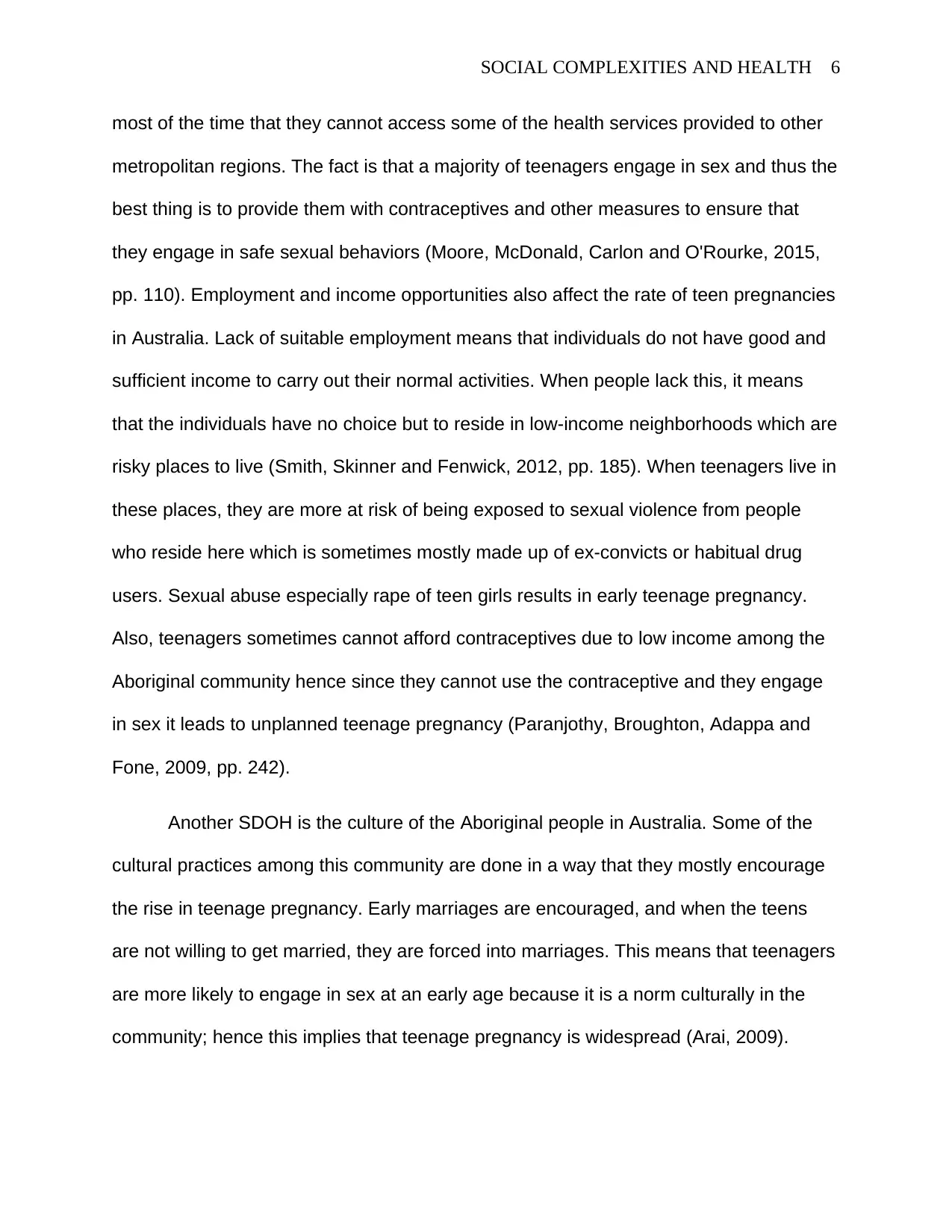
SOCIAL COMPLEXITIES AND HEALTH 6
most of the time that they cannot access some of the health services provided to other
metropolitan regions. The fact is that a majority of teenagers engage in sex and thus the
best thing is to provide them with contraceptives and other measures to ensure that
they engage in safe sexual behaviors (Moore, McDonald, Carlon and O'Rourke, 2015,
pp. 110). Employment and income opportunities also affect the rate of teen pregnancies
in Australia. Lack of suitable employment means that individuals do not have good and
sufficient income to carry out their normal activities. When people lack this, it means
that the individuals have no choice but to reside in low-income neighborhoods which are
risky places to live (Smith, Skinner and Fenwick, 2012, pp. 185). When teenagers live in
these places, they are more at risk of being exposed to sexual violence from people
who reside here which is sometimes mostly made up of ex-convicts or habitual drug
users. Sexual abuse especially rape of teen girls results in early teenage pregnancy.
Also, teenagers sometimes cannot afford contraceptives due to low income among the
Aboriginal community hence since they cannot use the contraceptive and they engage
in sex it leads to unplanned teenage pregnancy (Paranjothy, Broughton, Adappa and
Fone, 2009, pp. 242).
Another SDOH is the culture of the Aboriginal people in Australia. Some of the
cultural practices among this community are done in a way that they mostly encourage
the rise in teenage pregnancy. Early marriages are encouraged, and when the teens
are not willing to get married, they are forced into marriages. This means that teenagers
are more likely to engage in sex at an early age because it is a norm culturally in the
community; hence this implies that teenage pregnancy is widespread (Arai, 2009).
most of the time that they cannot access some of the health services provided to other
metropolitan regions. The fact is that a majority of teenagers engage in sex and thus the
best thing is to provide them with contraceptives and other measures to ensure that
they engage in safe sexual behaviors (Moore, McDonald, Carlon and O'Rourke, 2015,
pp. 110). Employment and income opportunities also affect the rate of teen pregnancies
in Australia. Lack of suitable employment means that individuals do not have good and
sufficient income to carry out their normal activities. When people lack this, it means
that the individuals have no choice but to reside in low-income neighborhoods which are
risky places to live (Smith, Skinner and Fenwick, 2012, pp. 185). When teenagers live in
these places, they are more at risk of being exposed to sexual violence from people
who reside here which is sometimes mostly made up of ex-convicts or habitual drug
users. Sexual abuse especially rape of teen girls results in early teenage pregnancy.
Also, teenagers sometimes cannot afford contraceptives due to low income among the
Aboriginal community hence since they cannot use the contraceptive and they engage
in sex it leads to unplanned teenage pregnancy (Paranjothy, Broughton, Adappa and
Fone, 2009, pp. 242).
Another SDOH is the culture of the Aboriginal people in Australia. Some of the
cultural practices among this community are done in a way that they mostly encourage
the rise in teenage pregnancy. Early marriages are encouraged, and when the teens
are not willing to get married, they are forced into marriages. This means that teenagers
are more likely to engage in sex at an early age because it is a norm culturally in the
community; hence this implies that teenage pregnancy is widespread (Arai, 2009).
⊘ This is a preview!⊘
Do you want full access?
Subscribe today to unlock all pages.

Trusted by 1+ million students worldwide
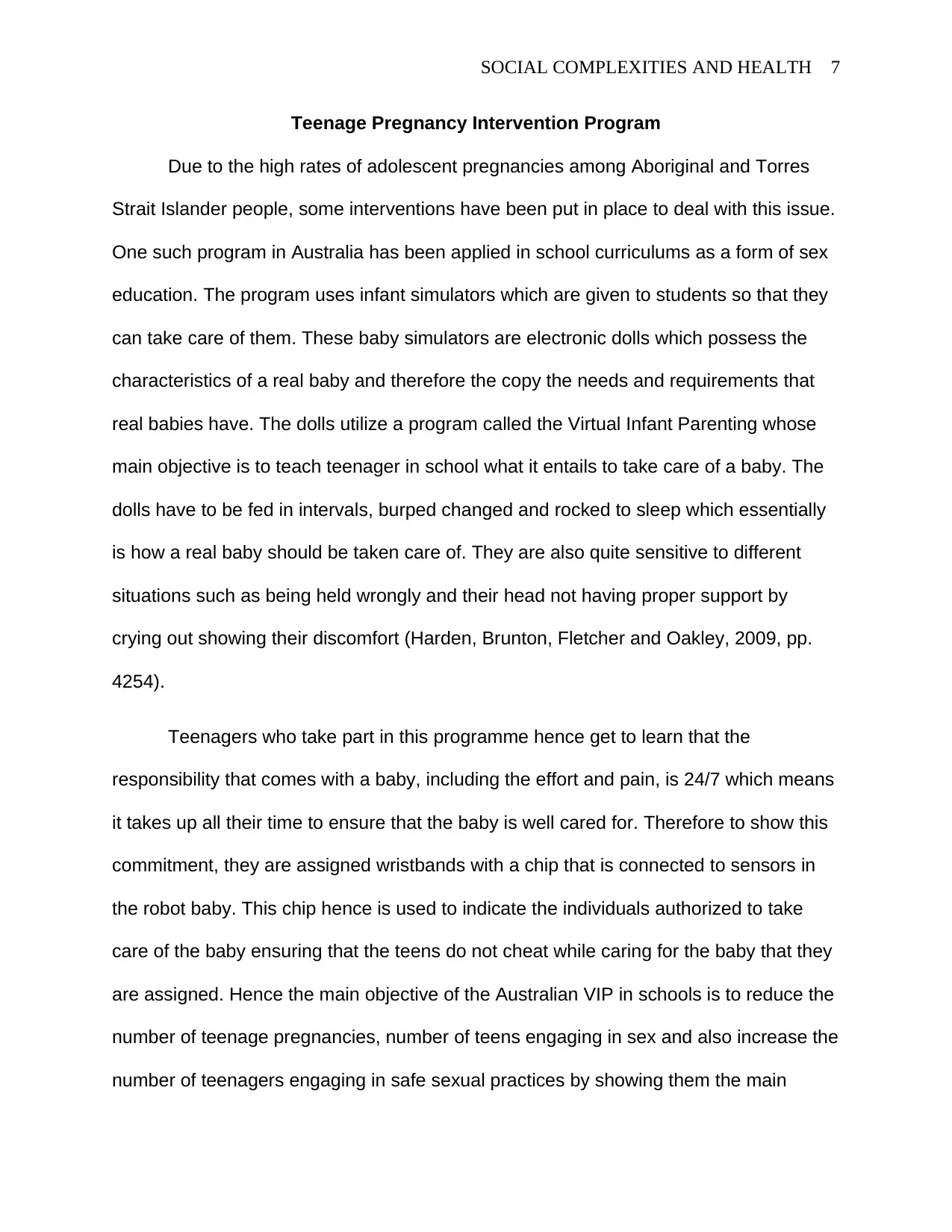
SOCIAL COMPLEXITIES AND HEALTH 7
Teenage Pregnancy Intervention Program
Due to the high rates of adolescent pregnancies among Aboriginal and Torres
Strait Islander people, some interventions have been put in place to deal with this issue.
One such program in Australia has been applied in school curriculums as a form of sex
education. The program uses infant simulators which are given to students so that they
can take care of them. These baby simulators are electronic dolls which possess the
characteristics of a real baby and therefore the copy the needs and requirements that
real babies have. The dolls utilize a program called the Virtual Infant Parenting whose
main objective is to teach teenager in school what it entails to take care of a baby. The
dolls have to be fed in intervals, burped changed and rocked to sleep which essentially
is how a real baby should be taken care of. They are also quite sensitive to different
situations such as being held wrongly and their head not having proper support by
crying out showing their discomfort (Harden, Brunton, Fletcher and Oakley, 2009, pp.
4254).
Teenagers who take part in this programme hence get to learn that the
responsibility that comes with a baby, including the effort and pain, is 24/7 which means
it takes up all their time to ensure that the baby is well cared for. Therefore to show this
commitment, they are assigned wristbands with a chip that is connected to sensors in
the robot baby. This chip hence is used to indicate the individuals authorized to take
care of the baby ensuring that the teens do not cheat while caring for the baby that they
are assigned. Hence the main objective of the Australian VIP in schools is to reduce the
number of teenage pregnancies, number of teens engaging in sex and also increase the
number of teenagers engaging in safe sexual practices by showing them the main
Teenage Pregnancy Intervention Program
Due to the high rates of adolescent pregnancies among Aboriginal and Torres
Strait Islander people, some interventions have been put in place to deal with this issue.
One such program in Australia has been applied in school curriculums as a form of sex
education. The program uses infant simulators which are given to students so that they
can take care of them. These baby simulators are electronic dolls which possess the
characteristics of a real baby and therefore the copy the needs and requirements that
real babies have. The dolls utilize a program called the Virtual Infant Parenting whose
main objective is to teach teenager in school what it entails to take care of a baby. The
dolls have to be fed in intervals, burped changed and rocked to sleep which essentially
is how a real baby should be taken care of. They are also quite sensitive to different
situations such as being held wrongly and their head not having proper support by
crying out showing their discomfort (Harden, Brunton, Fletcher and Oakley, 2009, pp.
4254).
Teenagers who take part in this programme hence get to learn that the
responsibility that comes with a baby, including the effort and pain, is 24/7 which means
it takes up all their time to ensure that the baby is well cared for. Therefore to show this
commitment, they are assigned wristbands with a chip that is connected to sensors in
the robot baby. This chip hence is used to indicate the individuals authorized to take
care of the baby ensuring that the teens do not cheat while caring for the baby that they
are assigned. Hence the main objective of the Australian VIP in schools is to reduce the
number of teenage pregnancies, number of teens engaging in sex and also increase the
number of teenagers engaging in safe sexual practices by showing them the main
Paraphrase This Document
Need a fresh take? Get an instant paraphrase of this document with our AI Paraphraser
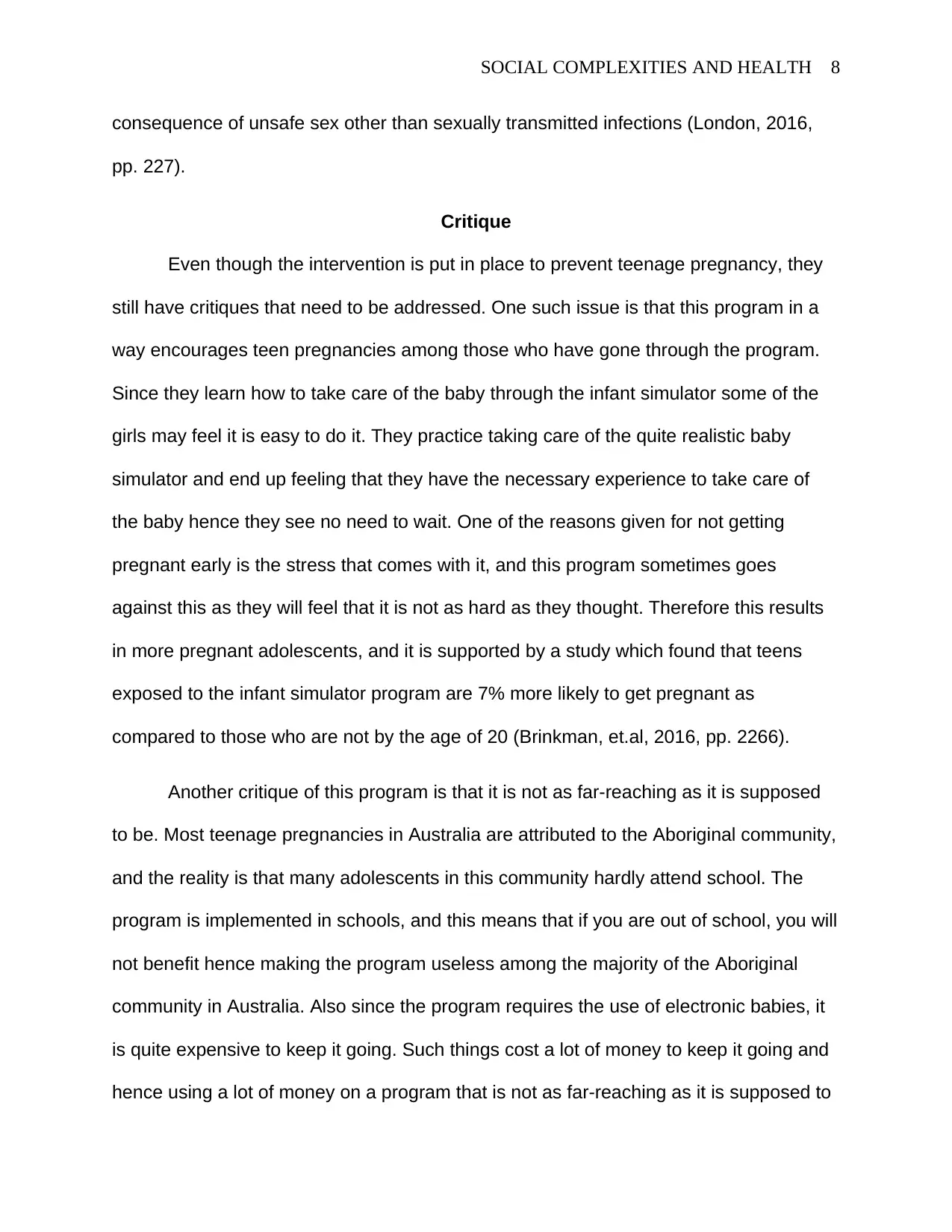
SOCIAL COMPLEXITIES AND HEALTH 8
consequence of unsafe sex other than sexually transmitted infections (London, 2016,
pp. 227).
Critique
Even though the intervention is put in place to prevent teenage pregnancy, they
still have critiques that need to be addressed. One such issue is that this program in a
way encourages teen pregnancies among those who have gone through the program.
Since they learn how to take care of the baby through the infant simulator some of the
girls may feel it is easy to do it. They practice taking care of the quite realistic baby
simulator and end up feeling that they have the necessary experience to take care of
the baby hence they see no need to wait. One of the reasons given for not getting
pregnant early is the stress that comes with it, and this program sometimes goes
against this as they will feel that it is not as hard as they thought. Therefore this results
in more pregnant adolescents, and it is supported by a study which found that teens
exposed to the infant simulator program are 7% more likely to get pregnant as
compared to those who are not by the age of 20 (Brinkman, et.al, 2016, pp. 2266).
Another critique of this program is that it is not as far-reaching as it is supposed
to be. Most teenage pregnancies in Australia are attributed to the Aboriginal community,
and the reality is that many adolescents in this community hardly attend school. The
program is implemented in schools, and this means that if you are out of school, you will
not benefit hence making the program useless among the majority of the Aboriginal
community in Australia. Also since the program requires the use of electronic babies, it
is quite expensive to keep it going. Such things cost a lot of money to keep it going and
hence using a lot of money on a program that is not as far-reaching as it is supposed to
consequence of unsafe sex other than sexually transmitted infections (London, 2016,
pp. 227).
Critique
Even though the intervention is put in place to prevent teenage pregnancy, they
still have critiques that need to be addressed. One such issue is that this program in a
way encourages teen pregnancies among those who have gone through the program.
Since they learn how to take care of the baby through the infant simulator some of the
girls may feel it is easy to do it. They practice taking care of the quite realistic baby
simulator and end up feeling that they have the necessary experience to take care of
the baby hence they see no need to wait. One of the reasons given for not getting
pregnant early is the stress that comes with it, and this program sometimes goes
against this as they will feel that it is not as hard as they thought. Therefore this results
in more pregnant adolescents, and it is supported by a study which found that teens
exposed to the infant simulator program are 7% more likely to get pregnant as
compared to those who are not by the age of 20 (Brinkman, et.al, 2016, pp. 2266).
Another critique of this program is that it is not as far-reaching as it is supposed
to be. Most teenage pregnancies in Australia are attributed to the Aboriginal community,
and the reality is that many adolescents in this community hardly attend school. The
program is implemented in schools, and this means that if you are out of school, you will
not benefit hence making the program useless among the majority of the Aboriginal
community in Australia. Also since the program requires the use of electronic babies, it
is quite expensive to keep it going. Such things cost a lot of money to keep it going and
hence using a lot of money on a program that is not as far-reaching as it is supposed to
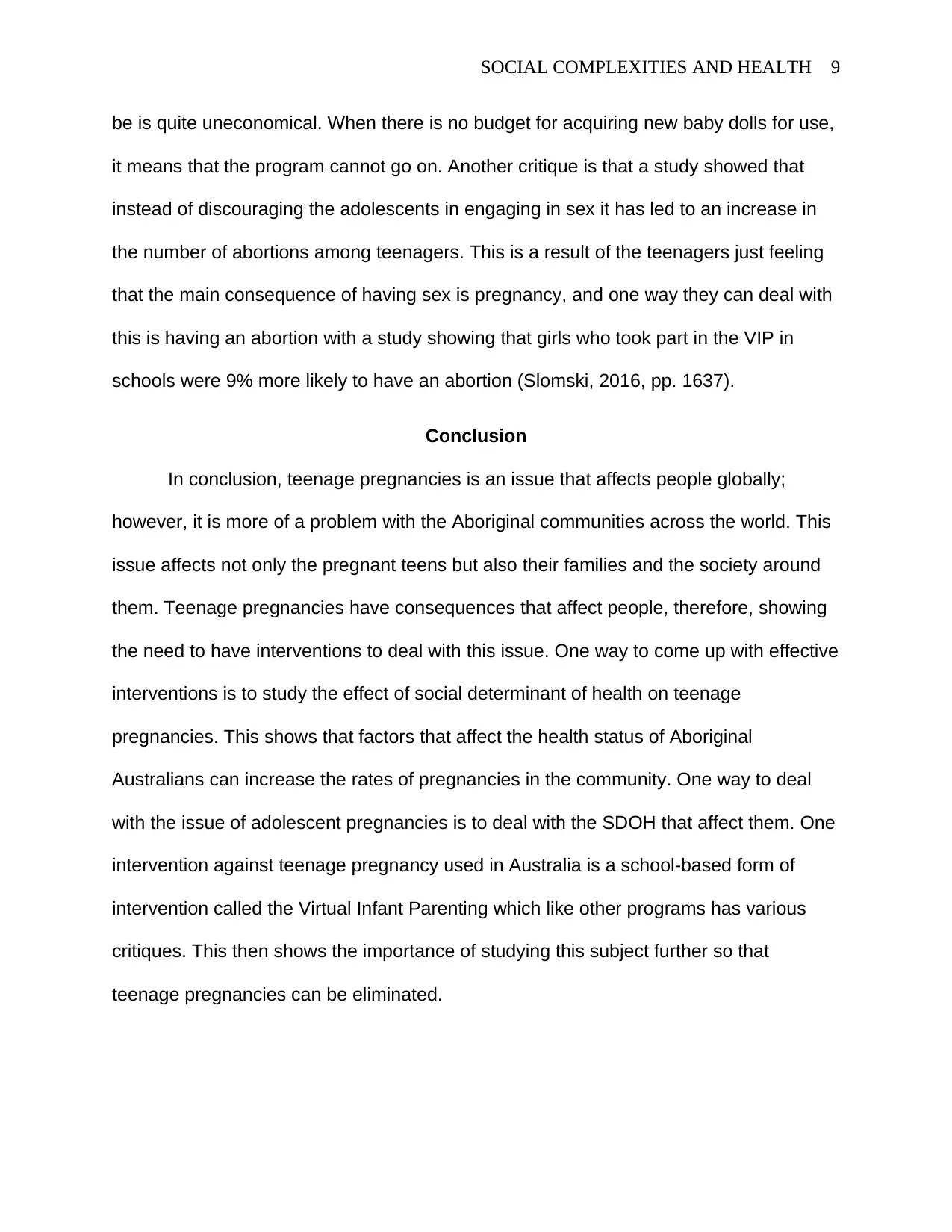
SOCIAL COMPLEXITIES AND HEALTH 9
be is quite uneconomical. When there is no budget for acquiring new baby dolls for use,
it means that the program cannot go on. Another critique is that a study showed that
instead of discouraging the adolescents in engaging in sex it has led to an increase in
the number of abortions among teenagers. This is a result of the teenagers just feeling
that the main consequence of having sex is pregnancy, and one way they can deal with
this is having an abortion with a study showing that girls who took part in the VIP in
schools were 9% more likely to have an abortion (Slomski, 2016, pp. 1637).
Conclusion
In conclusion, teenage pregnancies is an issue that affects people globally;
however, it is more of a problem with the Aboriginal communities across the world. This
issue affects not only the pregnant teens but also their families and the society around
them. Teenage pregnancies have consequences that affect people, therefore, showing
the need to have interventions to deal with this issue. One way to come up with effective
interventions is to study the effect of social determinant of health on teenage
pregnancies. This shows that factors that affect the health status of Aboriginal
Australians can increase the rates of pregnancies in the community. One way to deal
with the issue of adolescent pregnancies is to deal with the SDOH that affect them. One
intervention against teenage pregnancy used in Australia is a school-based form of
intervention called the Virtual Infant Parenting which like other programs has various
critiques. This then shows the importance of studying this subject further so that
teenage pregnancies can be eliminated.
be is quite uneconomical. When there is no budget for acquiring new baby dolls for use,
it means that the program cannot go on. Another critique is that a study showed that
instead of discouraging the adolescents in engaging in sex it has led to an increase in
the number of abortions among teenagers. This is a result of the teenagers just feeling
that the main consequence of having sex is pregnancy, and one way they can deal with
this is having an abortion with a study showing that girls who took part in the VIP in
schools were 9% more likely to have an abortion (Slomski, 2016, pp. 1637).
Conclusion
In conclusion, teenage pregnancies is an issue that affects people globally;
however, it is more of a problem with the Aboriginal communities across the world. This
issue affects not only the pregnant teens but also their families and the society around
them. Teenage pregnancies have consequences that affect people, therefore, showing
the need to have interventions to deal with this issue. One way to come up with effective
interventions is to study the effect of social determinant of health on teenage
pregnancies. This shows that factors that affect the health status of Aboriginal
Australians can increase the rates of pregnancies in the community. One way to deal
with the issue of adolescent pregnancies is to deal with the SDOH that affect them. One
intervention against teenage pregnancy used in Australia is a school-based form of
intervention called the Virtual Infant Parenting which like other programs has various
critiques. This then shows the importance of studying this subject further so that
teenage pregnancies can be eliminated.
⊘ This is a preview!⊘
Do you want full access?
Subscribe today to unlock all pages.

Trusted by 1+ million students worldwide
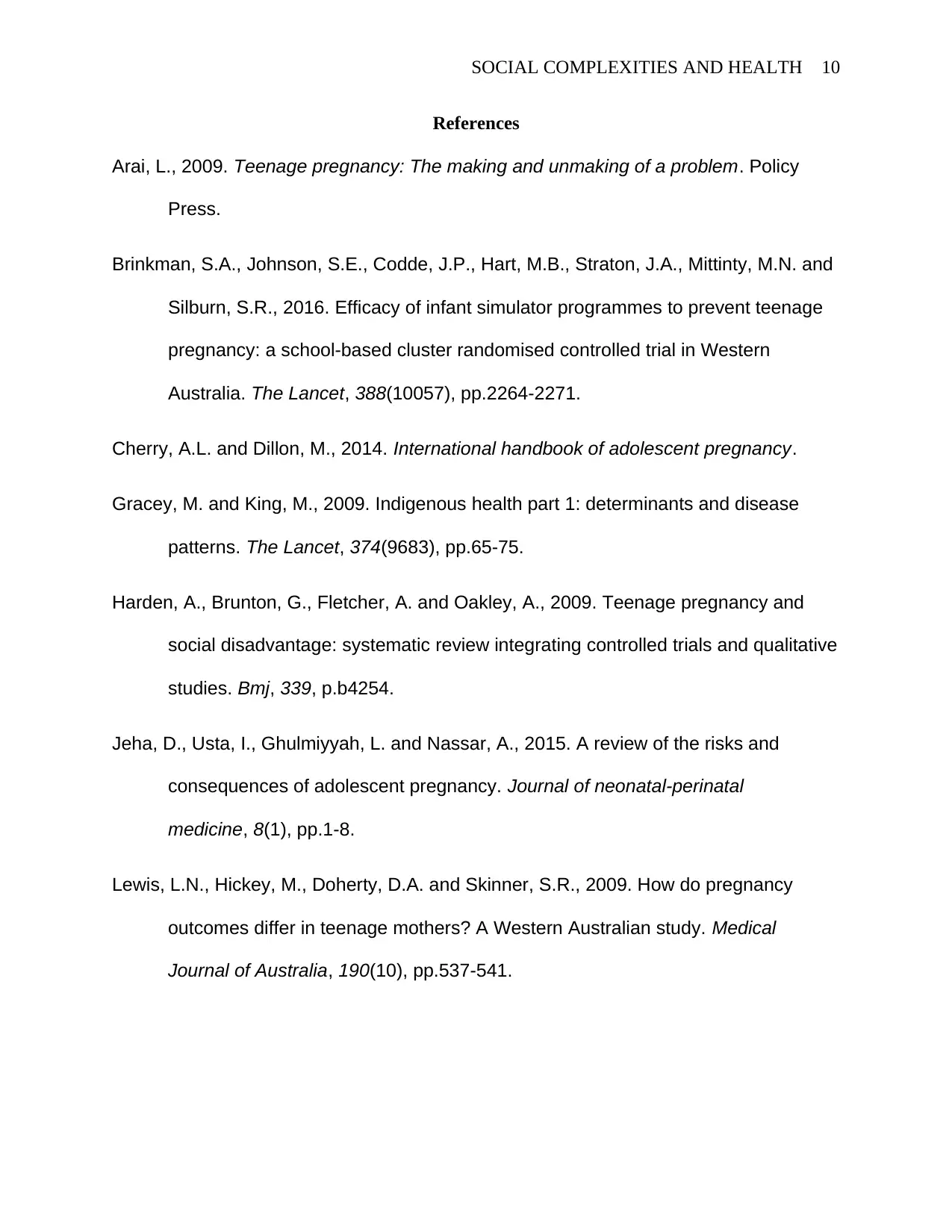
SOCIAL COMPLEXITIES AND HEALTH 10
References
Arai, L., 2009. Teenage pregnancy: The making and unmaking of a problem. Policy
Press.
Brinkman, S.A., Johnson, S.E., Codde, J.P., Hart, M.B., Straton, J.A., Mittinty, M.N. and
Silburn, S.R., 2016. Efficacy of infant simulator programmes to prevent teenage
pregnancy: a school-based cluster randomised controlled trial in Western
Australia. The Lancet, 388(10057), pp.2264-2271.
Cherry, A.L. and Dillon, M., 2014. International handbook of adolescent pregnancy.
Gracey, M. and King, M., 2009. Indigenous health part 1: determinants and disease
patterns. The Lancet, 374(9683), pp.65-75.
Harden, A., Brunton, G., Fletcher, A. and Oakley, A., 2009. Teenage pregnancy and
social disadvantage: systematic review integrating controlled trials and qualitative
studies. Bmj, 339, p.b4254.
Jeha, D., Usta, I., Ghulmiyyah, L. and Nassar, A., 2015. A review of the risks and
consequences of adolescent pregnancy. Journal of neonatal-perinatal
medicine, 8(1), pp.1-8.
Lewis, L.N., Hickey, M., Doherty, D.A. and Skinner, S.R., 2009. How do pregnancy
outcomes differ in teenage mothers? A Western Australian study. Medical
Journal of Australia, 190(10), pp.537-541.
References
Arai, L., 2009. Teenage pregnancy: The making and unmaking of a problem. Policy
Press.
Brinkman, S.A., Johnson, S.E., Codde, J.P., Hart, M.B., Straton, J.A., Mittinty, M.N. and
Silburn, S.R., 2016. Efficacy of infant simulator programmes to prevent teenage
pregnancy: a school-based cluster randomised controlled trial in Western
Australia. The Lancet, 388(10057), pp.2264-2271.
Cherry, A.L. and Dillon, M., 2014. International handbook of adolescent pregnancy.
Gracey, M. and King, M., 2009. Indigenous health part 1: determinants and disease
patterns. The Lancet, 374(9683), pp.65-75.
Harden, A., Brunton, G., Fletcher, A. and Oakley, A., 2009. Teenage pregnancy and
social disadvantage: systematic review integrating controlled trials and qualitative
studies. Bmj, 339, p.b4254.
Jeha, D., Usta, I., Ghulmiyyah, L. and Nassar, A., 2015. A review of the risks and
consequences of adolescent pregnancy. Journal of neonatal-perinatal
medicine, 8(1), pp.1-8.
Lewis, L.N., Hickey, M., Doherty, D.A. and Skinner, S.R., 2009. How do pregnancy
outcomes differ in teenage mothers? A Western Australian study. Medical
Journal of Australia, 190(10), pp.537-541.
Paraphrase This Document
Need a fresh take? Get an instant paraphrase of this document with our AI Paraphraser
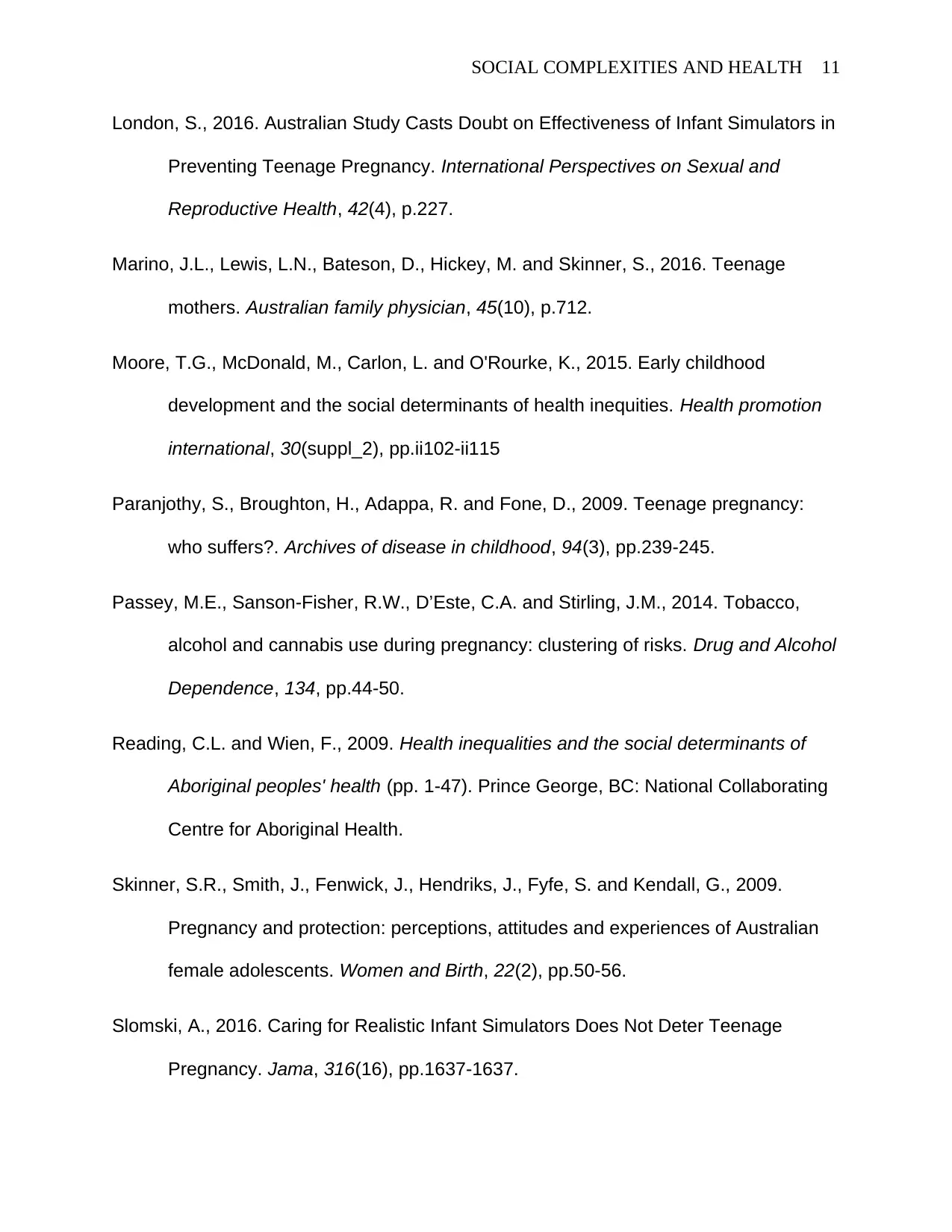
SOCIAL COMPLEXITIES AND HEALTH 11
London, S., 2016. Australian Study Casts Doubt on Effectiveness of Infant Simulators in
Preventing Teenage Pregnancy. International Perspectives on Sexual and
Reproductive Health, 42(4), p.227.
Marino, J.L., Lewis, L.N., Bateson, D., Hickey, M. and Skinner, S., 2016. Teenage
mothers. Australian family physician, 45(10), p.712.
Moore, T.G., McDonald, M., Carlon, L. and O'Rourke, K., 2015. Early childhood
development and the social determinants of health inequities. Health promotion
international, 30(suppl_2), pp.ii102-ii115
Paranjothy, S., Broughton, H., Adappa, R. and Fone, D., 2009. Teenage pregnancy:
who suffers?. Archives of disease in childhood, 94(3), pp.239-245.
Passey, M.E., Sanson-Fisher, R.W., D’Este, C.A. and Stirling, J.M., 2014. Tobacco,
alcohol and cannabis use during pregnancy: clustering of risks. Drug and Alcohol
Dependence, 134, pp.44-50.
Reading, C.L. and Wien, F., 2009. Health inequalities and the social determinants of
Aboriginal peoples' health (pp. 1-47). Prince George, BC: National Collaborating
Centre for Aboriginal Health.
Skinner, S.R., Smith, J., Fenwick, J., Hendriks, J., Fyfe, S. and Kendall, G., 2009.
Pregnancy and protection: perceptions, attitudes and experiences of Australian
female adolescents. Women and Birth, 22(2), pp.50-56.
Slomski, A., 2016. Caring for Realistic Infant Simulators Does Not Deter Teenage
Pregnancy. Jama, 316(16), pp.1637-1637.
London, S., 2016. Australian Study Casts Doubt on Effectiveness of Infant Simulators in
Preventing Teenage Pregnancy. International Perspectives on Sexual and
Reproductive Health, 42(4), p.227.
Marino, J.L., Lewis, L.N., Bateson, D., Hickey, M. and Skinner, S., 2016. Teenage
mothers. Australian family physician, 45(10), p.712.
Moore, T.G., McDonald, M., Carlon, L. and O'Rourke, K., 2015. Early childhood
development and the social determinants of health inequities. Health promotion
international, 30(suppl_2), pp.ii102-ii115
Paranjothy, S., Broughton, H., Adappa, R. and Fone, D., 2009. Teenage pregnancy:
who suffers?. Archives of disease in childhood, 94(3), pp.239-245.
Passey, M.E., Sanson-Fisher, R.W., D’Este, C.A. and Stirling, J.M., 2014. Tobacco,
alcohol and cannabis use during pregnancy: clustering of risks. Drug and Alcohol
Dependence, 134, pp.44-50.
Reading, C.L. and Wien, F., 2009. Health inequalities and the social determinants of
Aboriginal peoples' health (pp. 1-47). Prince George, BC: National Collaborating
Centre for Aboriginal Health.
Skinner, S.R., Smith, J., Fenwick, J., Hendriks, J., Fyfe, S. and Kendall, G., 2009.
Pregnancy and protection: perceptions, attitudes and experiences of Australian
female adolescents. Women and Birth, 22(2), pp.50-56.
Slomski, A., 2016. Caring for Realistic Infant Simulators Does Not Deter Teenage
Pregnancy. Jama, 316(16), pp.1637-1637.
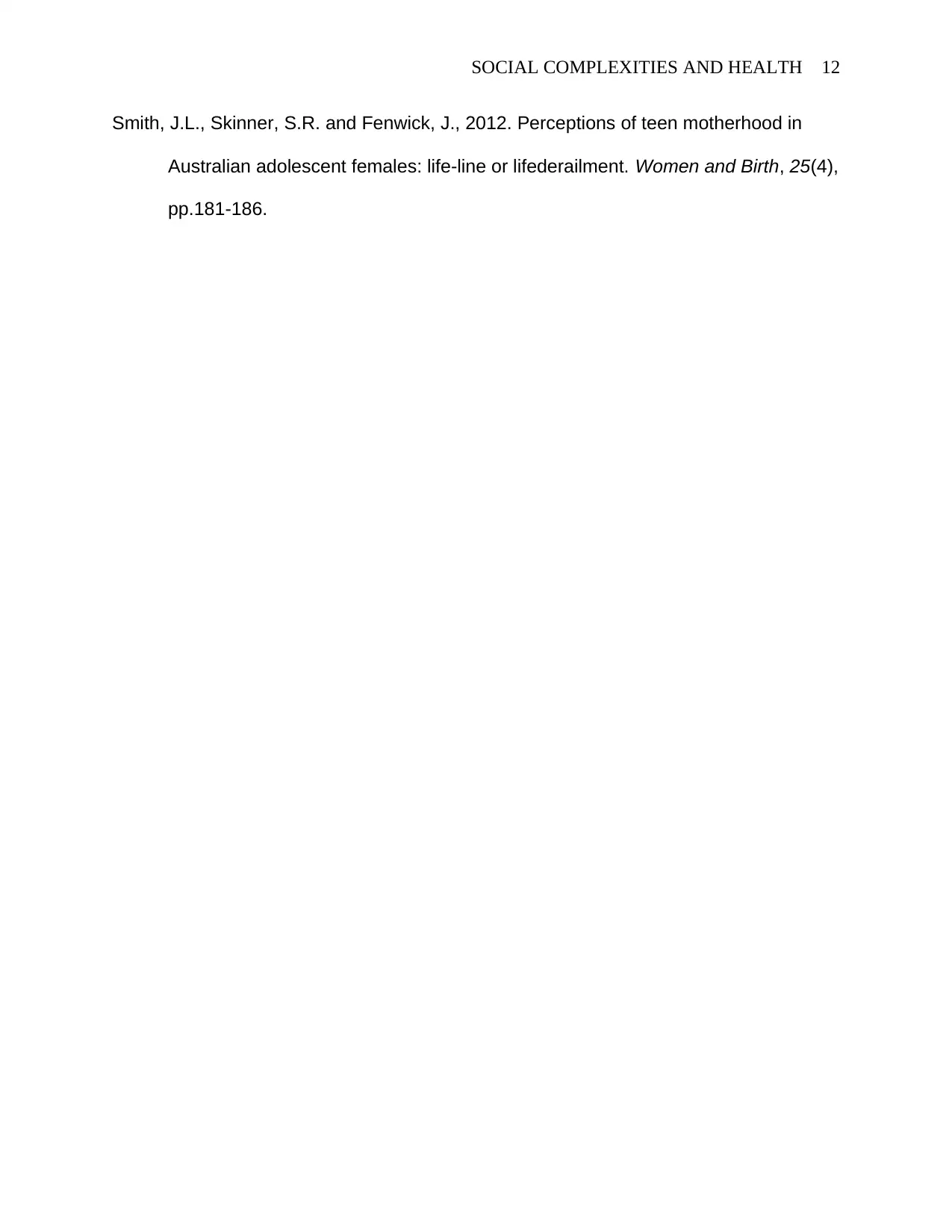
SOCIAL COMPLEXITIES AND HEALTH 12
Smith, J.L., Skinner, S.R. and Fenwick, J., 2012. Perceptions of teen motherhood in
Australian adolescent females: life-line or lifederailment. Women and Birth, 25(4),
pp.181-186.
Smith, J.L., Skinner, S.R. and Fenwick, J., 2012. Perceptions of teen motherhood in
Australian adolescent females: life-line or lifederailment. Women and Birth, 25(4),
pp.181-186.
⊘ This is a preview!⊘
Do you want full access?
Subscribe today to unlock all pages.

Trusted by 1+ million students worldwide
1 out of 12
Related Documents
Your All-in-One AI-Powered Toolkit for Academic Success.
+13062052269
info@desklib.com
Available 24*7 on WhatsApp / Email
![[object Object]](/_next/static/media/star-bottom.7253800d.svg)
Unlock your academic potential
Copyright © 2020–2025 A2Z Services. All Rights Reserved. Developed and managed by ZUCOL.





